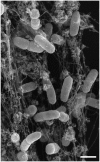An overview of the role of neutrophils in innate immunity, inflammation and host-biomaterial integration
- PMID: 28149530
- PMCID: PMC5274707
- DOI: 10.1093/rb/rbw041
An overview of the role of neutrophils in innate immunity, inflammation and host-biomaterial integration
Abstract
Despite considerable recent progress in defining neutrophil functions and behaviors in tissue repair, much remains to be determined with regards to its overall role in the tissue integration of biomaterials. This article provides an overview of the neutrophil's numerous, important roles in both inflammation and resolution, and subsequently, their role in biomaterial integration. Neutrophils function in three primary capacities: generation of oxidative bursts, release of granules and formation of neutrophil extracellular traps (NETs); these combined functions enable neutrophil involvement in inflammation, macrophage recruitment, M2 macrophage differentiation, resolution of inflammation, angiogenesis, tumor formation and immune system activation. Neutrophils exhibit great flexibility to adjust to the prevalent microenvironmental conditions in the tissue; thus, the biomaterial composition and fabrication will potentially influence neutrophil behavior following confrontation. This review serves to highlight the neutrophil's plasticity, reiterating that neutrophils are not just simple suicidal killers, but the true maestros of resolution and regeneration.
Keywords: NETosis; host response; inflammation; neutrophil; tissue engineering; tissue regeneration.
Figures





References
-
- Anderson J. Exploiting the inflammatory response on biomaterials research and development. J Mater Sci Mater Med, ESB Biocompatibility studies 2014;26:5423-45. - PubMed
-
- Radic MZ, Bowlin GL. Innate immunity response to tissue engineering templates: the determinant. J Tissue Sci Eng 2014;5:1.
-
- Anderson JM. Biological responses to materials. Annu Rev Mater Res 2001;31:81–110.
Publication types
LinkOut - more resources
Full Text Sources
Other Literature Sources
Medical

